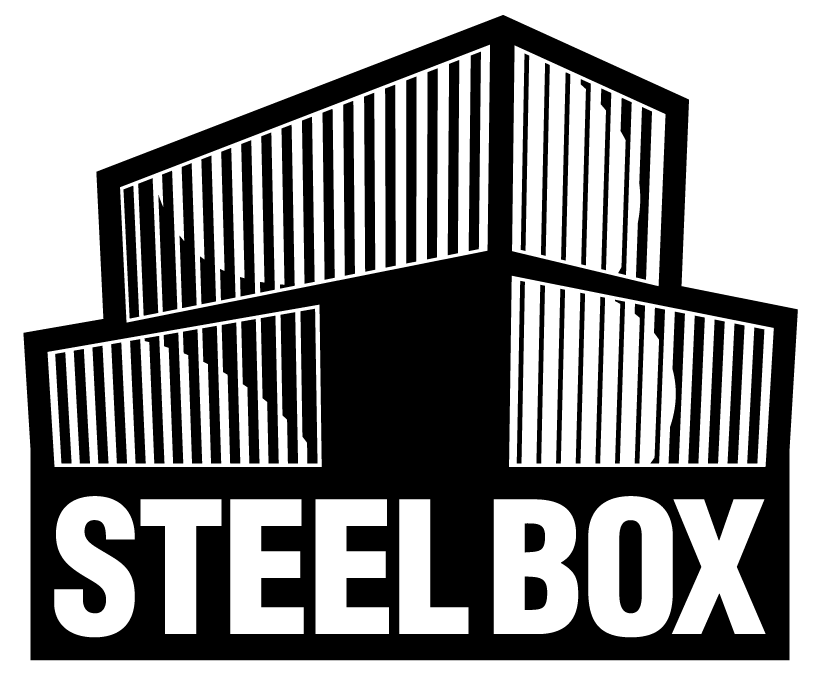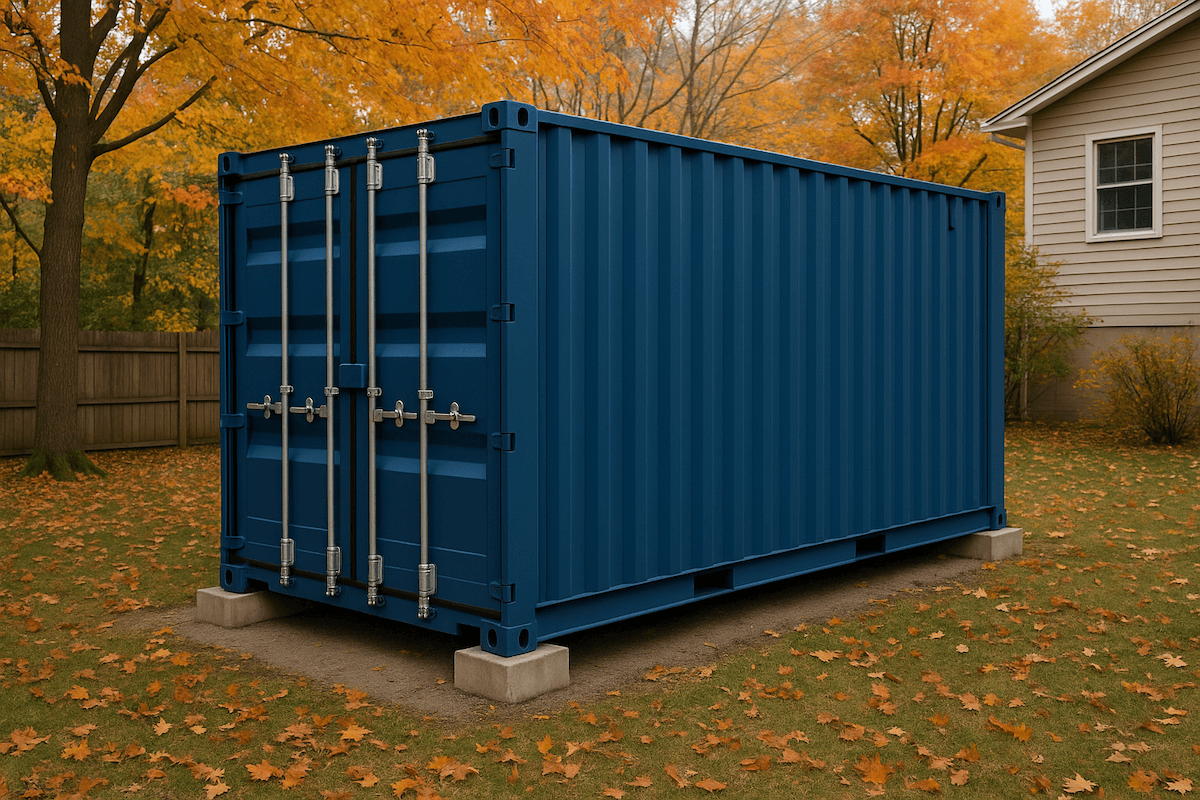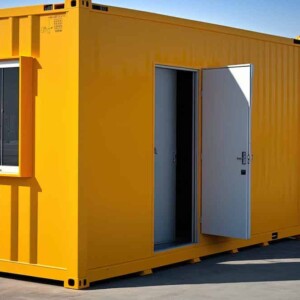Are you building with shipping containers? That’s awesome, but before you jump into floorplans and aesthetics, you need a good foundation. Foundations keep your container level, sturdy, and safeguarded from moisture or shifting ground.
In this blog post, we’ll cover 7 types of foundations, each proven to work well for certain budgets, sites, and project scales. Here at Steel Box Shipping Containers, we’ve worked with thousands of customers to find the right foundation for all sorts of projects from backyard storage sheds to full container homes – and now we’re going to share our insights so you can get it right from the beginning.
TL;DR
Constructing with shipping containers? The foundation you build will be the most important choice you make. In this article we will explain 7 of the most common foundation types:
Permanent Foundations: From concrete slabs (the most stable and most expensive) to pier foundations (inexpensive corner support) to helical piles (quick, no concrete). The right choice depends on the type of building, if it’s multi-story, and the soil conditions.
Temporary Foundations: Wood skids (inexpensive and removable), steel skids (easy to move with equipment), and gravel pads (easy for DIY). Best for storage containers, workshops or other buildings you may want to move.
Key Takeaways:
- Your foundation must go below the frost line to prevent shifting
- The best type for you is dependent on the soil type, local climate, your budget, and permitting.
- A 40-foot container is 8,500+ pounds and needs to be adequately supported.
- Consult a structural engineer beforehand.
Select a foundation based on whether you are going for a permanent or temporary installation (home vs storage), your soil conditions, and how easily the site can be accessed.
What is a shipping container foundation?
Simply put, your container’s foundation is the structure that supports your shipping container and keeps it off the ground. It’s what goes between the raw earth and the underside of your steel box. It can be as simple as a few concrete blocks at the corners or as complex as a full basement with poured concrete walls – it depends on your situation and local building codes.
Check out our guide to shipping container sizes and dimensions for planning your foundation footprint.
Why Shipping Containers Need A Foundation
Stability
Shipping containers are designed to stack perfectly on ships and trains all over the world, but the ground isn’t a flat steel deck. Your container will gradually shift as the soil settles and moves with weather conditions if it isn’t set on a good foundation. This can cause doors to jam, the floor to slope, and stress on the steel frame. A proper foundation locks everything into place so it stays exactly where you want it over the long term.
Corrosion Prevention
Steel doesn’t play nice with moisture. When a container is placed directly on the soil, ground moisture will wick up through the earth and start corroding the steel bottom. Even Corten steel will rust through if it’s constantly exposed to damp conditions. Elevating your container with a foundation provides an air gap that will protect it from ground moisture and keep your container in good condition for decades longer.
Support
A 20-foot container weighs about 4,500 pounds empty, and a 40-foot container comes in at 8,500 pounds or more – that’s a lot of steel – and this is before you fill it with anything or make any modifications. All of this weight needs to be properly distributed so that your container doesn’t sink into soft ground or create pressure points that damage the structure. A foundation will spread the load across a wider area and transfer it safely down into the earth below.
The 7 Shipping Container Foundation Ideas
Foundation Idea #1: Full Concrete Slab Foundation (The Gold Standard)
When building a full concrete slab, you will be pouring concrete over the entire footprint of your container in one single pour. This creates a completely solid base and is the best and most expensive option, giving you maximum stability, nearly foolproof moisture protection, and very easy utility hookups. The only downside is it can’t be easily modified or moved later on. For these reasons, a full concrete slab is best for permanent residential homes in harsh climates and windy or earthquake-prone areas.
Foundation Idea #2: Concrete Pier or Footing Foundation (Simple & Cost-Effective)
Concrete pads that are individually poured and located below your frost line to support only the four corners of your container – the bare minimum you can get away with but still have it function. The concrete piers are extremely cost effective, but they can be a bit more complicated to level out over several points. And, since you’ll have easy access underneath, running plumbing and adding insulation is much easier than with other foundations. Best suited for simpler, non-residential structures like garden sheds or workshops built in moderate climates on sloped or uneven lots.
Foundation Idea #3: Concrete Stem Wall Foundation (The Traditional Look)
The more traditional style foundation of concrete footings with a continuous vertical wall that run around the perimeter of your container, often creating a crawlspace or even a basement underneath. This provides an excellent thermal break between the ground and container, the most traditional house look, and a large amount of space to hide all of your utility hookups. The downside is it costs a bit more than just using piers or a full slab since you’re adding more concrete work. This type of foundation works best when integrating containers with traditional house additions, or if you want the space of a crawlspace to tuck away HVAC units and storage.
Foundation Idea #4: Helical Piles / Screw Piles (The Quick Option)
Essentially large steel screws that are drilled deep into the ground until they reach load-bearing soil, essentially creating a giant ground anchor. Installation is lightning fast, with no curing times, and there is also very minimal disturbance to the site. The downside is they can be expensive per pile, and also require specialized equipment to install. Best suited for sites with poor soil conditions, environmentally sensitive areas, or extreme cold climates with deep frost lines.
Foundation Idea #5: Railroad Ties or Treated Wood Skids (The Temporary Solution)
Heavy duty, pressure-treated lumber or repurposed railroad ties laid out on their side on a prepared gravel bed. This is the absolute fastest and dirtiest way to get your shipping container off the ground, and it can be easily removed with some extra hands at the end of the build. Perfect if you’re building something temporary like a storage shed or temporary job site office, but never recommended for anything you’ll live in since the wood will eventually rot. And since you’ll need a thick bed of gravel underneath, it’s not well-suited for cold climates with deep frost lines either. This type of foundation is also best used for testing out an idea or initial design before committing to something more permanent down the line.
Foundation Idea #6: Steel Skid / Runner Foundation (Industrial Style)
Welding your container directly to heavy steel beams (skids) that then rest on pre-leveled strips of concrete or a compacted gravel pad creates a seriously industrial, heavy-duty feel. These provide excellent strength and also make it possible to move your container short distances with the right heavy equipment, but welding steel to steel creates a thermal bridge that needs to be carefully accounted for with your insulation. Steel runners are best for commercial builds, art studios, workshops, or any structure that might need to be relocated now and then.
Foundation Idea #7: Gravel Pad / Compacted Fill (The Minimalist Approach)
Excavating a designated area and then backfilling it with layers of compacted crushed gravel is the minimalist way to create a base for your shipping container. This is an excellent way to ensure fast drainage, is relatively inexpensive and can be done by DIYers in a pinch. The major downside is that it’s not considered a true permanent foundation since the ground can settle and shift over time. Best suited for storing a single shipping container, very small cabins, or in areas with excellent natural drainage.
How to Choose Your Foundation
We’ve talked with thousands of container buyers about what foundation to use. Based on those discussions, here’s some basics to keep in mind as you plan:
Ground Conditions
The composition and stability of the ground can make a huge difference in foundation choice. Clay holds moisture and swells/contracts a lot. Sand drains well but shifts with changes in moisture. Rock provides a solid base but is hard to excavate. If your soil is soft, unstable or highly variable you may need to go deeper with your foundation – using helical piles or concrete piers for instance – while high-quality, well-drained soil can get by with simpler solutions like a gravel pad.
Cold Climate and Frost Line
If you live anywhere that experiences cold winters, your foundation must go below the frost line for your region – the depth where the ground actually freezes solid. Water in the soil freezes and expands during cold weather, a process called “frost heave” that will slowly raise and shift your container over time. Ask your local building department how deep you need to go in your area.
Price Range and Permits
One of the truisms of foundation work is that cheap often means temporary – a wood skid foundation might run you $500 but a full concrete slab is going to cost $5,000-$15,000 or more. Local building codes may also come into play if you’re building a permitted residential building – meaning you may have no choice about the foundation required no matter what your budget is. Check with your local building department before you spend time, effort and money on a foundation that won’t pass inspection.
Access to Site
Can a concrete truck get to your property? If you’re building in a remote location, a tight space or on difficult terrain, concrete can become very expensive or downright impossible to pour. Helical piles and wood or steel skids are two examples of foundations that can be installed with portable equipment instead of large machinery, making them ideal if access to the site is limited.
Still not sure what foundation is best for your project? Our container experts have seen thousands of successful installations and can help you walk through the pros and cons based on your specific location, budget and intended use. Call us before you break ground and we’ll help you choose the right foundation the first time.
Foundation Preparation & Installation Tips
Site Preparation
Before any foundation work begins, clear vegetation, rocks, and debris from the area to get down to bare earth. Use a laser level or transit to ensure your site is flat, and grade the surrounding area so water drains away from your container. Standing water is your foundation’s enemy, so consider adding French drains if your site holds water.
Concrete Slab Thickness
If you’re going with a concrete slab foundation, plan on 4-6 inches of thickness reinforced with rebar or wire mesh to prevent cracking. For heavier loads or multi-container projects, you may need 6-8 inches with additional reinforcement. The concrete needs at least 7 days to cure before placing your container, though 28 days is ideal for full strength.
Securing Your Container to the Foundation
The most common approach is to embed steel plates or anchor bolts in wet concrete at each of your container’s four corners, then weld or bolt the container’s corner castings to those anchors once the concrete has cured.
If you’re temporarily setting a container on wood or steel skids (rather than a permanent foundation), twist locks (same ones used on ships) work well and will allow for relocation in the future. Regardless of the type of fasteners you use, always secure all four corners, as wind pressure on a single corner can shift or even flip an unsecured container.
Don’t understand how containers get transported and placed in shipping container homes and offices? Read our complete guide to moving shipping containers.
Regional Considerations for Container Foundations
Steel Box has customers from all over Texas and the Southwest, and we get that foundation recommendations often need to be region-specific. We are locals so we are well aware of what your area deals with:
North Texas: freeze/thaw which calls for a foundation that goes down below the frost line (usually 12-18″ deep) – we have Dallas, Fort Worth, and Panhandle customers we assist with this regularly.
Central and South Texas: expansive clay that expands and contracts with precipitation changes – we see a lot of proper drainage with pier foundations as the optimal solution in Austin, San Antonio, Houston, and other areas to avoid settlement.
West Texas: rocky and hard-packed soil that is difficult to excavate but provides great natural bearing capacity – gravel pads and pier foundations are common in El Paso, Midland, and other areas.
Coastal Texas: sandy soils, high humidity and humidity corrosion, and hurricane-force winds and debris – many of our Gulf Coast customers from Corpus Christi to Beaumont choose concrete slabs or helical piles with proper anchoring and corrosion protection.
Rural/remote areas: across Texas there can be access limitations which often make helical piles or wood skids the only practical solution – we’ve had successful deliveries to ranches, oil field locations, and land that is many miles from a paved road.
Steel Box wants you to know that you are getting more than a shipping container when you work with us; you get Texas localized knowledge to help you avoid making a costly misstep for your area.
Conclusion
There’s no single “best” foundation for shipping containers. You have to choose the right foundation for the job based on permanence, site conditions, local climate, and your budget. A storage container is not the same project as a container home, for example, and they have very different needs.
Do consult with a structural engineer or local building professional before you begin. Foundations are expensive, so you don’t want to make a costly mistake and risk not passing inspection or meeting local building codes. A good foundation sets everything up for success on your container project.
Ready to Start Your Container Project?
Steel Box Shipping Containers is your complete source for a successful container project:
- Premium containers in a wide variety of sizes, new or used, to meet your needs, including cargo-worthy containers.
- Expert delivery to your prepared foundation site, so your container is delivered safely.
- Guidance in selecting the right type of container for your foundation, whether standard or specialty.
- Low prices, with instant online quotes so you don’t have to wait.
- Experience and knowledge gained from real container delivery experts that have moved thousands of containers across the country.
Get your instant quote in 30 seconds or give our container experts a call at 512-240-6710 and let us know about your foundation choice, delivery options and any other questions you have about your project. We’re happy to help get you started!





